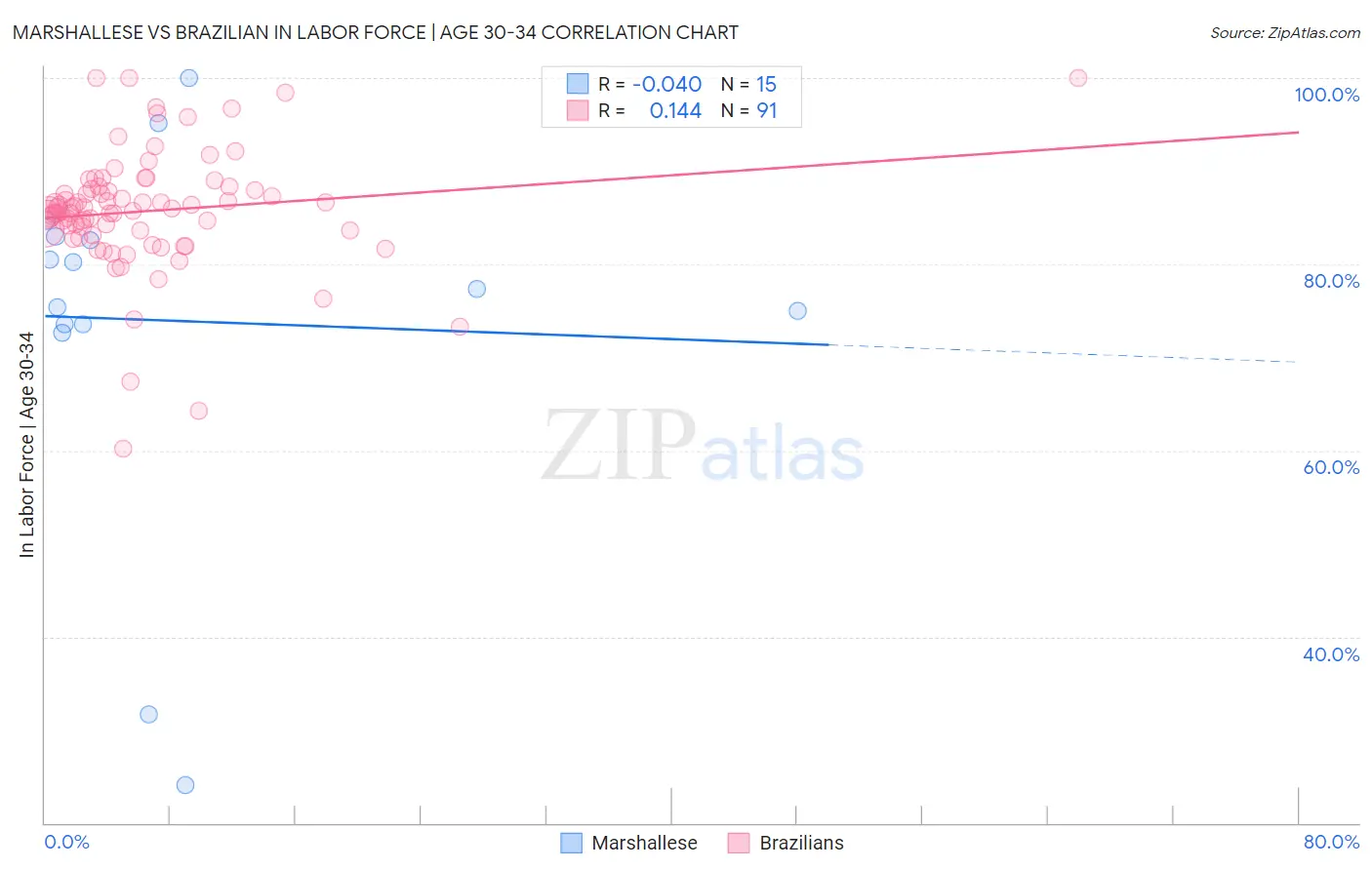Marshallese vs Brazilian In Labor Force | Age 30-34
COMPARE
Marshallese
Brazilian
In Labor Force | Age 30-34
In Labor Force | Age 30-34 Comparison
Marshallese
Brazilians
79.2%
IN LABOR FORCE | AGE 30-34
0.0/ 100
METRIC RATING
335th/ 347
METRIC RANK
85.4%
IN LABOR FORCE | AGE 30-34
99.1/ 100
METRIC RATING
70th/ 347
METRIC RANK
Marshallese vs Brazilian In Labor Force | Age 30-34 Correlation Chart
The statistical analysis conducted on geographies consisting of 14,760,991 people shows no correlation between the proportion of Marshallese and labor force participation rate among population between the ages 30 and 34 in the United States with a correlation coefficient (R) of -0.040 and weighted average of 79.2%. Similarly, the statistical analysis conducted on geographies consisting of 323,771,960 people shows a poor positive correlation between the proportion of Brazilians and labor force participation rate among population between the ages 30 and 34 in the United States with a correlation coefficient (R) of 0.144 and weighted average of 85.4%, a difference of 7.8%.

In Labor Force | Age 30-34 Correlation Summary
| Measurement | Marshallese | Brazilian |
| Minimum | 24.0% | 60.2% |
| Maximum | 100.0% | 100.0% |
| Range | 76.0% | 39.8% |
| Mean | 73.9% | 85.7% |
| Median | 77.3% | 86.0% |
| Interquartile 25% (IQ1) | 73.5% | 83.6% |
| Interquartile 75% (IQ3) | 82.9% | 88.0% |
| Interquartile Range (IQR) | 9.4% | 4.4% |
| Standard Deviation (Sample) | 20.3% | 6.5% |
| Standard Deviation (Population) | 19.6% | 6.4% |
Similar Demographics by In Labor Force | Age 30-34
Demographics Similar to Marshallese by In Labor Force | Age 30-34
In terms of in labor force | age 30-34, the demographic groups most similar to Marshallese are Hopi (79.3%, a difference of 0.030%), Native/Alaskan (79.2%, a difference of 0.080%), Yakama (79.1%, a difference of 0.12%), Pima (79.0%, a difference of 0.24%), and Apache (79.0%, a difference of 0.27%).
| Demographics | Rating | Rank | In Labor Force | Age 30-34 |
| Sioux | 0.0 /100 | #328 | Tragic 80.4% |
| Creek | 0.0 /100 | #329 | Tragic 80.4% |
| Pueblo | 0.0 /100 | #330 | Tragic 80.0% |
| Houma | 0.0 /100 | #331 | Tragic 79.9% |
| Kiowa | 0.0 /100 | #332 | Tragic 79.8% |
| Inupiat | 0.0 /100 | #333 | Tragic 79.7% |
| Hopi | 0.0 /100 | #334 | Tragic 79.3% |
| Marshallese | 0.0 /100 | #335 | Tragic 79.2% |
| Natives/Alaskans | 0.0 /100 | #336 | Tragic 79.2% |
| Yakama | 0.0 /100 | #337 | Tragic 79.1% |
| Pima | 0.0 /100 | #338 | Tragic 79.0% |
| Apache | 0.0 /100 | #339 | Tragic 79.0% |
| Ute | 0.0 /100 | #340 | Tragic 78.9% |
| Immigrants | Yemen | 0.0 /100 | #341 | Tragic 78.2% |
| Tohono O'odham | 0.0 /100 | #342 | Tragic 77.7% |
Demographics Similar to Brazilians by In Labor Force | Age 30-34
In terms of in labor force | age 30-34, the demographic groups most similar to Brazilians are Immigrants from Japan (85.4%, a difference of 0.0%), Immigrants from China (85.4%, a difference of 0.010%), Indian (Asian) (85.4%, a difference of 0.010%), Maltese (85.4%, a difference of 0.010%), and Immigrants from Iran (85.4%, a difference of 0.020%).
| Demographics | Rating | Rank | In Labor Force | Age 30-34 |
| Macedonians | 99.4 /100 | #63 | Exceptional 85.5% |
| Italians | 99.4 /100 | #64 | Exceptional 85.4% |
| Senegalese | 99.4 /100 | #65 | Exceptional 85.4% |
| Ghanaians | 99.4 /100 | #66 | Exceptional 85.4% |
| Kenyans | 99.3 /100 | #67 | Exceptional 85.4% |
| Immigrants | Eastern Europe | 99.3 /100 | #68 | Exceptional 85.4% |
| Immigrants | Iran | 99.2 /100 | #69 | Exceptional 85.4% |
| Brazilians | 99.1 /100 | #70 | Exceptional 85.4% |
| Immigrants | Japan | 99.1 /100 | #71 | Exceptional 85.4% |
| Immigrants | China | 99.0 /100 | #72 | Exceptional 85.4% |
| Indians (Asian) | 99.0 /100 | #73 | Exceptional 85.4% |
| Maltese | 99.0 /100 | #74 | Exceptional 85.4% |
| Immigrants | Czechoslovakia | 99.0 /100 | #75 | Exceptional 85.4% |
| Iranians | 99.0 /100 | #76 | Exceptional 85.4% |
| Immigrants | Eastern Asia | 98.9 /100 | #77 | Exceptional 85.4% |